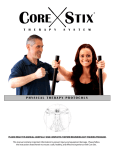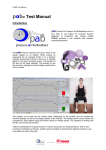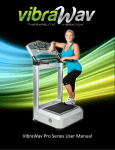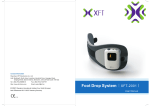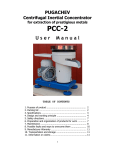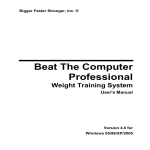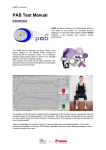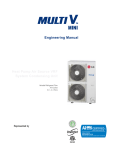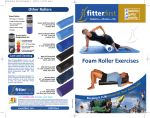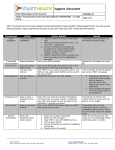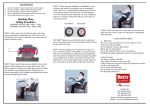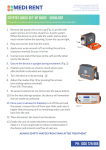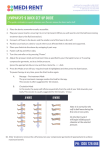Download “Stretching BACK Into Shape” - Medi-Dyne
Transcript
Welcome to CoreStretch CoreStretch TM Each year we lose flexibility in our muscles, tendons and ligaments. This loss in flexibility directly correlates to increase risk of injury and a decrease in athletic performance. Because the back is the core of our skeletal and muscular system its health is vital to our bodies overall performance. Yet, this is also why the back continues to be one of the leading causes of pain and discomfort. “Stretching BACK I n t o S h a p e ” CoreStretch was designed to stretch the back, shoulders and legs better than traditional and conventional methods. Corestretch’s unique design elongates the back, stretching the muscles, tendons and ligaments not only in the back, but also those in your legs that work in conjunction with the back. Traditional and conventional back stretching methods are either to difficult to use or force the back to curve instead of elongate. CoreStretch is also light and collapsible making it easy to transport for use anywhere you go. Stretching Guidelines • • • • Stretching is more effective after warming up and also after exercise. Never bounce or jerk when stretching Hold each stretch 10-30 seconds Never stretch to the point of pain. Stretch to the point of mild tension in the muscles and then relax as you hold the stretch. • Focus on breathing slowly, deeply and naturally. Proper breathing aids relaxation which enhances your stretching success. Proper Technique For best results, it is important that the CoreStretch be properly sized (adjusted in length) and positioned correctly. To position the CoreStretch correctly, first set the padded foam bar on you lap at your waist, approximately the same position as your waist or belt line. It is preferable that the numbers face you, with the number 1 on top and the number 10 on the bottom For proper sizing, adjust the CoreStretch on one of the settings, numbered 1-10. Depress the button and lengthen the CoreStretch to the number which fully extends your arms and straightens your back but still allows for a comfortable grip with your hands. You are now ready to use the CoreStretch. The attached stretching poster demonstrates a variety of stretches that may be performed using the CoreStretch. Please note that there are three levels of stretching and that not all stretches are recommended at each level. For beginners it is recommended that you start in a seated/chair position, working your way up to the intermediate or standing/supported position and if possible the advanced or seated/floor position. For additional instruction, a DVD is available on-line at www.medi-dyne.com or by calling 817-251-8660 or toll free in the United States at 800-810-1740. www.medi-dyne.com Finally, an effective stretching device for your • Back • Shoulders • Hips • Hamstrings • & Shins CoreStretch TM Intermediate stretches in a standing position “ S t r e tching BACK Into Shape” (can also be done leaning against a wall for support) For best results, please read the stretching guidelines and directions for proper technique included on the reverse side of this poster. Also, be sure that your arms are fully extended (not bent at the elbow) and your back is straight (not curved) as shown in the diagram below. This will maximize your back elongation and stretch. Correct Height Correct Posture Incorrect Height Lower Back A d v a n c e d s t r e t c h in g s it t i n g o n t h e f l o o r Lower Back & Hamstrings Advanced Lat Lower & Upper Back & Shoulders Incorrect Posture With legs straight, slowly lean forward. Slightly bend the knees and slowly lean forward. You may also lean side to side emphasizing a side or specific target area. Slightly bend the knees, cross your arms (see inset) and slowly lean forward. Peroneal (Outer Calf & Ankle) Lateral (outside) Hamstrings With legs straight and slightly separated, grip the handle with one hand and support yourself on the floor with the other. Lean toward the supporting hand. Reverse hands for other side. B e g in ning stretches in a seated position Lower Back Lower & Upper Back & Shoulders Lats & Lateral Scapula Advanced Lateral Lats & Lateral Scapula Medial (inner) Calf & Medial (inner) Hamstrings Lower Back & Hamstrings With legs spread, invert toes (point inward) and slowly lean forward. Groin & Hamstrings Keep legs bent and slowly lean forward. You may also lean side to side emphasizing a side or specific target area. Lower Back & Hamstrings Legs bent, cross your arms (see inset) and slowly lean forward. Lower Back, Hamstrings & Shins Reverse your hands so that your palms are facing upwards (see inset) and slowly lean forward Grip the handle with one hand and support yourself on the chair with the other hand. Lean toward the supporting hand. Reverse hands for other side. Slightly bend the knees. Reverse your hands so that your palms are facing upwards (see inset) and slowly lean forward Straighten your legs and slowly lean forward. With legs spread, evert toes (point outward) and slowly lean forward. Hip (Piriformis) Upper Glute & I.T. Band With legs spread, slowly lean forward. As always, if you have had any recent physical problems or surgery, or if you are just beginning to exercise, especially after a long absence, please consult your physician. As with any new stretching technique, it is recommended that you start slowly using the beginner positions and then gradually progress to the more advanced positions and techniques. Position yourself on the edge of your seat. Straighten your legs and slowly lean forward. This can also be done one leg at a time. Sitting on the edge of your chair, straighten your legs and point your toes. Slowly lean forward. Sitting comfortably in your chair, cross the leg of the hip you want to stretch and slowly lean forward. www.medi-dyne.com


